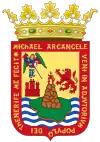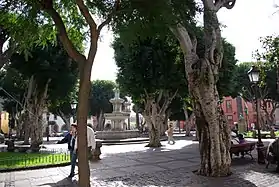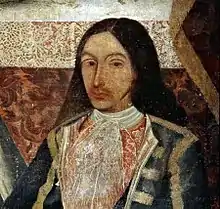San Cristóbal de La Laguna
San Cristóbal de La Laguna (commonly known as La Laguna, Spanish pronunciation: [saŋ kɾisˈtoβal de la laˈɣuna]) is a city and municipality in the northern part of the island of Tenerife in the Province of Santa Cruz de Tenerife, on the Canary Islands (Spain). The city is the third-most populous city of the archipelago and the second-most populous city of the island. La Laguna's historical center was declared a World Heritage Site by UNESCO in 1999. In 2003 the municipality started an ambitious Urban Plan to renew this area, that was carried out by the firm AUC S.L. (Arquitectura Urbanismo y Cooperación). The city was the ancient capital of the Canary Islands.[2] La Laguna lies right alongside the city of Santa Cruz de Tenerife; thus, the two cities and municipalities form a single large urban center, linked by tram.[3][4][5]
San Cristóbal de La Laguna | |
|---|---|
Municipality and city | |
 Clockwise from top: University of La Laguna, Shrine of Cristo de La Laguna, Forests, Cathedral of La Laguna, Panoramic city, Iglesia de la Concepción, Consejo Consultivo de Canarias, Plaza del Adelantado and city council. | |
 Flag  Coat of arms | |
| Nickname(s): "La Ciudad de los Adelantados", "La Ciudad de Aguere". | |
 Municipal location in Tenerife | |
 San Cristóbal de La Laguna Location in Tenerife  San Cristóbal de La Laguna San Cristóbal de La Laguna (Canary Islands)  San Cristóbal de La Laguna San Cristóbal de La Laguna (Spain, Canary Islands) | |
| Coordinates: 28°29′N 16°18′W | |
| Country | Spain |
| Autonomous community | Canary Islands |
| Province | Santa Cruz de Tenerife |
| Government | |
| • Mayor | Luis Yeray Gutiérrez (PSOE) |
| Area | |
| • Total | 102.6 km2 (39.6 sq mi) |
| Elevation | 543 m (1,781 ft) |
| Population (2018)[1] | |
| • Total | 155,549 |
| • Density | 1,500/km2 (3,900/sq mi) |
| Time zone | UTC0 (WET) |
| • Summer (DST) | UTC+1 (WEST) |
| Postal code | 38200 |
| Official language(s) | Spanish |
| Website | Official website |
| Criteria | Cultural: (ii), (iv) |
| Reference | 929 |
| Inscription | 1999 (23rd session) |
| Area | 60.38 ha (149.2 acres) |
| Buffer zone | 23.71 ha (58.6 acres) |

The city is home to the University of La Laguna which is home to 30,000 students; these are not included in the population figures for the city. La Laguna is considered to be the cultural capital of the Canary Islands. Also there is in the habit of being calling the "Ciudad de los Adelantados", for having been the first university city of the archipelago.
Its economy is business-oriented while agriculture dominates the northeastern portion of the city. The urban area dominates the central and the southern parts. Tourism covers the northern coast. The main industry includes some manufacturing. The industrial area is made up of the main subdivisions of Majuelos, Las Torres de Taco, Las Mantecas and Las Chumberas. In this city one finds the legendary house of the spectre of Catalina Lercaro, as well as the incorrupt body of Sor María de Jesús, and the Christ of La Laguna (Cristo de La Laguna). Another emblematic building of the city is the Cathedral of La Laguna, which is the Catholic cathedral of Tenerife and its diocese (Diocese of Tenerife).
Other important historical figures of the city were Amaro Pargo, one of the famous corsairs of the Golden Age of Piracy, and José de Anchieta, Catholic saint and missionary and founder of the cities of São Paulo and Rio de Janeiro in Brazil.
In 2010, after a survey, La Laguna was listed as the city with the best reputation in the Canary Islands and the third provincial capital city of Spain with the best reputation, behind Gijon and Marbella.[6]
Etymology
At first the place where the town was called "Aguere" by the aboriginal Guanches (the name is still used in the literature). Later he founded the city as "Villa de San Cristóbal de La Gran Laguna" (in memory of a pond or lake that was in place). Later he established the San Cristóbal de La Laguna, and today is known simply as "La Laguna" (the lake).
Coat of arms
The coat of arms was granted by Queen Joanna of Castile on 23 March 1510, as arms of the island of Tenerife. The town of La Laguna, being the capital of the island during the first times after the Conquest, adopted this emblem as its own. It features an island with a volcano spitting fire, on waves, between a castle and a lion, and above the Archangel Saint Michael, holding a spear in one hand and a shield in the other. In the border, the inscription Michael Arcangele Veni in Adjutorium Populo Dei Thenerife Me Fecit. These elements symbolize the incorporation of the island of Tenerife to the Crown of Castile and its evangelization under the patronage of Saint Michael.
Subdivisions
- La Verdellada
- Viña Nava
- El Coromoto
- San Benito
- El Bronco
- La Cuesta
- Taco
- Tejina
- Valleguerra
- Bajamar
- Punta del Hidalgo
- Geneto
- Los Baldios
- Guamasa
- El Ortigal
- Las Mercedes
- El Batan
- Las Carboneras
- San Diego
- Las Gavias
Climate
Owing to its northerly aspect that captures moisture from the prevailing northeasterly winds, San Cristóbal de La Laguna has a mediterranean climate (Köppen: Csb) that contrasts with the arid climate of other cities on the Canary Islands, with three to five times more rainfall than on the southern slopes, around ten percent less sunshine, and about ten percent higher humidity throughout the year. In spite of its elevation, the maritime and subtropical influences keep the temperature above frost at all times.
| Climate data for La Laguna (1981–2010) – Tenerife North Airport (altitude: 632 m) | |||||||||||||
|---|---|---|---|---|---|---|---|---|---|---|---|---|---|
| Month | Jan | Feb | Mar | Apr | May | Jun | Jul | Aug | Sep | Oct | Nov | Dec | Year |
| Record high °C (°F) | 25.8 (78.4) |
26.9 (80.4) |
33.2 (91.8) |
33.0 (91.4) |
37.6 (99.7) |
37.9 (100.2) |
41.4 (106.5) |
41.2 (106.2) |
38.0 (100.4) |
33.2 (91.8) |
31.0 (87.8) |
25.2 (77.4) |
41.4 (106.5) |
| Average high °C (°F) | 16.0 (60.8) |
16.7 (62.1) |
18.2 (64.8) |
18.5 (65.3) |
20.1 (68.2) |
22.2 (72.0) |
24.7 (76.5) |
25.7 (78.3) |
24.9 (76.8) |
22.5 (72.5) |
19.7 (67.5) |
17.1 (62.8) |
20.5 (68.9) |
| Daily mean °C (°F) | 13.1 (55.6) |
13.4 (56.1) |
14.5 (58.1) |
14.7 (58.5) |
16.1 (61.0) |
18.1 (64.6) |
20.2 (68.4) |
21.2 (70.2) |
20.7 (69.3) |
18.9 (66.0) |
16.5 (61.7) |
14.3 (57.7) |
16.8 (62.2) |
| Average low °C (°F) | 10.2 (50.4) |
10.0 (50.0) |
10.7 (51.3) |
10.9 (51.6) |
12.0 (53.6) |
14.0 (57.2) |
15.7 (60.3) |
16.6 (61.9) |
16.5 (61.7) |
15.2 (59.4) |
13.3 (55.9) |
11.5 (52.7) |
13.0 (55.4) |
| Record low °C (°F) | 3.2 (37.8) |
3.4 (38.1) |
2.0 (35.6) |
4.2 (39.6) |
6.0 (42.8) |
8.5 (47.3) |
8.5 (47.3) |
7.0 (44.6) |
9.2 (48.6) |
6.8 (44.2) |
6.2 (43.2) |
3.5 (38.3) |
2.0 (35.6) |
| Average rainfall mm (inches) | 80 (3.1) |
70 (2.8) |
61 (2.4) |
39 (1.5) |
19 (0.7) |
11 (0.4) |
6 (0.2) |
5 (0.2) |
16 (0.6) |
47 (1.9) |
81 (3.2) |
82 (3.2) |
517 (20.2) |
| Average rainy days (≥ 1.0 mm) | 11 | 10 | 10 | 10 | 7 | 4 | 3 | 3 | 5 | 10 | 10 | 12 | 95 |
| Average relative humidity (%) | 76 | 75 | 71 | 74 | 72 | 73 | 69 | 69 | 71 | 74 | 75 | 79 | 73 |
| Mean monthly sunshine hours | 150 | 168 | 188 | 203 | 234 | 237 | 262 | 269 | 213 | 194 | 155 | 137 | 2,410 |
| Source: Agencia Estatal de Meteorología[7] | |||||||||||||
History

The place where the city is built belonged to the Menceyato de Anaga, which was one of nine aboriginal Guanche kingdoms on the island until the Kingdom of Castile's conquest. It is also known that the whole valley of Aguere (where the city lies) and especially the large lake that was in this place, was a place of pilgrimage for the aborigines of the island.[8]
The Battle of Aguere was fought here in 1494. The city was founded between 1496 and 1497 by Alonso Fernández de Lugo and was the capital of the island after the conclusion of the conquest of the islands. Later the city also became the capital of all of the Canary Islands. In 1582, the city suffered a virulent black plague epidemic that produced between 5,000 and 9,000 deaths.[9]
The layout of the city, its streets and its environment are elements shared with colonial cities in the Americas and Old Havana in Cuba, Lima in Peru, Cartagena de Indias in Colombia, or San Juan de Puerto Rico, among others. Since the urban plan of the city of La Laguna was the model for these Latin American cities.[10]
The coastal area was later raided by pirates. The University of La Laguna was founded in 1701.
A declining population and economy in the 18th century resulted in the transfer of the capital to Santa Cruz de Tenerife in 1723. Santa Cruz has since been the capital of the island of Tenerife and the sole capital of the Canary Islands until 1927, after which the capital of the archipelago has been shared with the city of Las Palmas de Gran Canaria.
The Tenerife North Airport at Los Rodeos was opened in the 1930s and is today expanding with low cost airlines using it.
It was declared a World Heritage Site on 2 December 1999. Several streets of historical significance have been closed off to automobile traffic. La Laguna has often been called the «Florence of the Canary Islands», this is due to its large number of churches and convents, as well as its old town and historic buildings.[11] Also due to the fact that the city was the cradle or seat of different artistic and cultural movements then exported to the rest of the Canary archipelago, especially in the religious sphere as in Holy Week, or having been the cradle in the Canaries of the movement of the Enlightenment, also called the «Century of Lights».[12] This favored the emergence especially in the Baroque period (XVII-XVIII centuries) of notable sculptors, painters and architects who exercised their trade in the city and sometimes exported their works to the rest of the archipelago.
Several tunnels, passages and underground vaults dating from the immediate aftermath of the founding of the city era have recently been found. These tunnels sometimes lie under very iconic buildings such as the Iglesia de la Concepción, the Cathedral of La Laguna and the former Convent of San Agustín, among others.[13] Researchers believe that the present city of La Laguna has been raised, because now it does not have the same ground level as at the time of its founding. In some places it is more than one meter higher and buries what is underneath.
Main sights
Folklore
La Laguna is home to some well known folklore in the Canary Islands. La Laguna has created around folklore groups.
Festivals and holidays
Romería de San Benito Abad
The Romería Regional de San Benito Abad, this is a popular romeria that is considered the most representative of the Canary Islands, which involves groups coming from all corners of the archipelago. The second Sunday of July is celebrated.[14] She is also considered among the most important romeria in Spain.[15] Courtship is carried through the streets in which people are dressed in traditional costumes and decorated with typical products bullock carts. Along the way throughout the city there are also Canarian folk music.
Holiday of the Cristo de La Laguna
It is celebrated every 14 September in honor of a much venerated image of Christ in the Canary Islands,[16] the Cristo de La Laguna. For this event come people from all over the archipelago. It is the leading holidays in town.
Holy Week
Holy Week in the city of San Cristóbal de la Laguna is the largest of the Canary Islands.[17] Holy Week has steps of great historical and artistic value, such as the aforementioned Cristo de La Laguna, accompanied by their guilds, some of them centuries old and which adopted the use of the hood in the nineteenth century, ride on the wheeled carts streets of the city.
Sister cities
 Cartagena de Indias, Colombia
Cartagena de Indias, Colombia São Paulo, Brazil
São Paulo, Brazil Telde, Spain
Telde, Spain Colima, Mexico[18]
Colima, Mexico[18]
People
- José de Anchieta (19 March 1534 – 9 June 1597), saint and important in the early colonial history of Brazil
- Juan Núñez de la Peña (1641–1721), a Spanish historian
- Amaro Pargo (1678–1747), famous Spanish corsair
- José Rodríguez de la Oliva (1695-1777): sculptor and painter of Baroque
- Cristóbal Bencomo y Rodríguez (1758-1835): priest, confessor of King Ferdinand VII of Spain and Titular Archbishop of Heraclea.
- Juan Domingo de Monteverde (1773–1832), military man
- Oscar Domínguez (9 January 1906 – 31 December 1957), Spanish painter and surrealist
- Antonio Cubillo (3 June 1930 - 10 December 2012), revolutionary and politician
- Suso Santana (2 March 1985-), footballer
- Sergio Rodriguez (12 June 1986-), basketball player
- Cristo Reyes (30 July 1987-), darts player
- Ana Guerra (1994-): singer. It jumped to the fame for being a contestant of the famous television program Operación Triunfo 2017.
References
- Municipal Register of Spain 2018. National Statistics Institute.
- "San Cristóbla de la Laguna". Arquitectuba (in Spanish). 2008. Archived from the original on 5 January 2009. Retrieved 5 April 2017.
- "La Laguna". Tenerife (in Spanish). Retrieved 10 July 2018.
- "PLAN TERRITORIAL ESPECIAL DE ORDENACIÓN DEL SISTEMA VIARIO DEL ÁREA METROPOLITANA DE TENERIFE" (PDF). Cabildo de Tenerife (in Spanish). pp. 566–576. Retrieved 10 July 2018.
- "Presentación general de la isla". Dracma (in Spanish). Retrieved 10 July 2018.
- "Estadísticas de Merco Ciudad". Merco (in Spanish). 2010. Archived from the original on 2 May 2011. Retrieved 10 July 2018.
- "Guía resumida del clima en España (1981–2010)". AEMET (in Spanish). 2010. Archived from the original on 18 November 2012. Retrieved 10 July 2018.
- Martín, Sabas (22 January 2000). "La Laguna. La ciudad de los sentidos". El Mundo (in Spanish). Retrieved 10 July 2018.
- La Peste. El cuarto jinete
- Rupérez, Beatriz. "La Laguna: ciudad colonial en Tenerife". El Nuevo Herald (in Spanish). pp. 1–2. Archived from the original on 9 April 2013. Retrieved 10 July 2018.
- Hernández Gutiérrez, A. Sebastián; González Chaves, Carmen Milagros (2008). Arquitectura para la ciudad burguesa: Canarias, siglo XIX (PDF) (in Spanish). Gobierno de Canarias. p. 237. ISBN 978-84-7947-469-0.
- Programa de la Semana Santa de La Laguna 2014
- R.C. (26 June 2009). "Pasadizos bajo La Laguna". ABC (in Spanish). Retrieved 10 July 2018.
- "Romería de San Benito Abad". Spain.info (in Spanish). Turespaña. Retrieved 10 July 2018.
- R.L.P. (9 July 2016). "Miles de romeros en San Benito, hacen hoy a La Laguna la capital de Canarias". ABC (in Spanish). Retrieved 10 July 2018.
- "El Cristo". Cristo de La Laguna. Archived from the original on 23 August 2007. Retrieved 10 July 2018.
- Fernández, Yolanda (2010). "Semana Santa en La Laguna 2010". Sobre Canarias (in Spanish). Retrieved 10 July 2018.
- El acto de hermanamiento de la ciudad de Colima con San Cristóbal de La Laguna se celebra el próximo 2 de mayo.
External links
| Wikimedia Commons has media related to San Cristóbal de La Laguna. |
| Wikivoyage has a travel guide for San Cristóbal de La Laguna. |
- http://www.aytolalaguna.com
- Organismo Autónomo de Deportes de La Laguna, featuring information about activities, installations, news, etc. (in Spanish)
- https://www.facebook.com/ParaMiLaLagunaEs/

